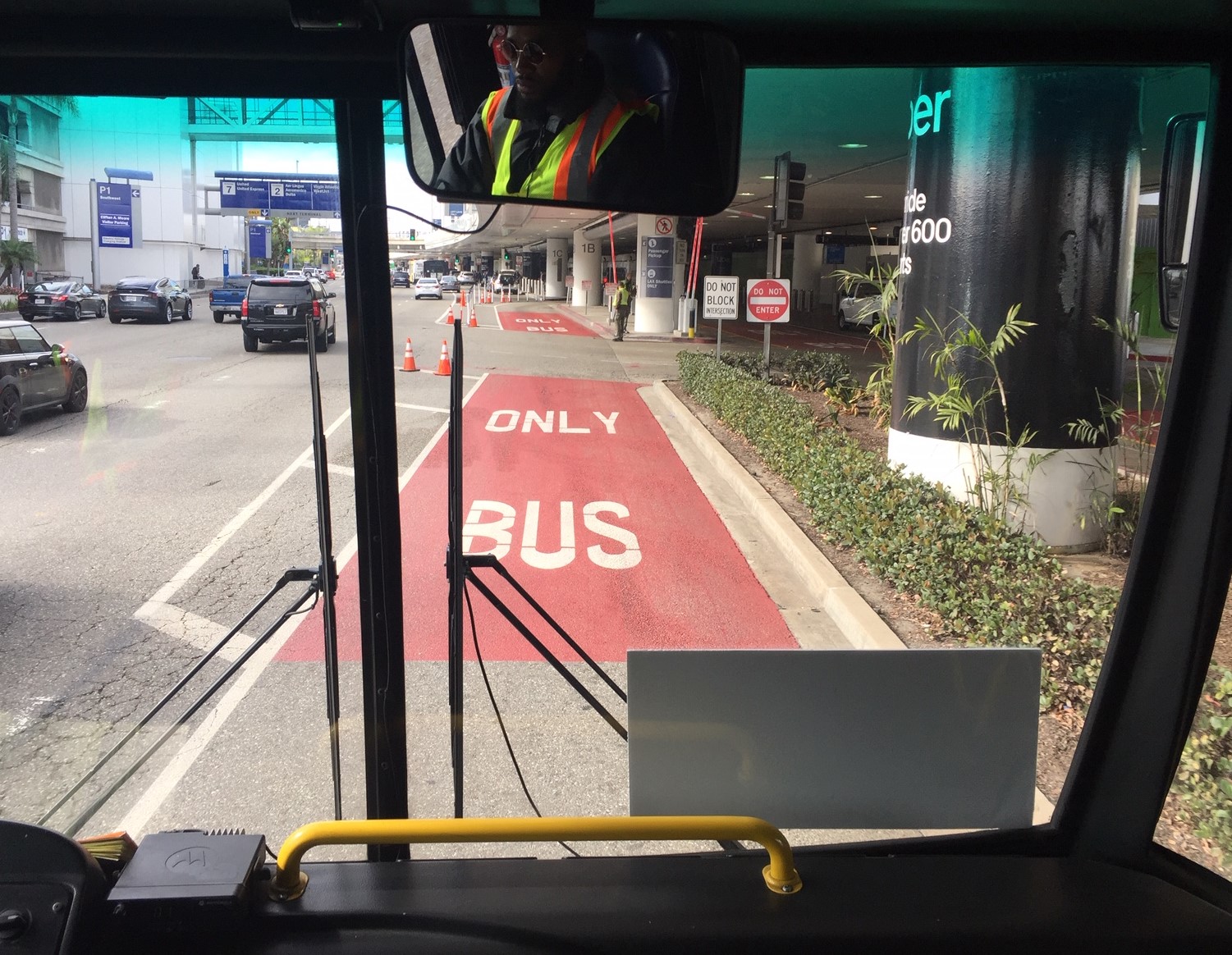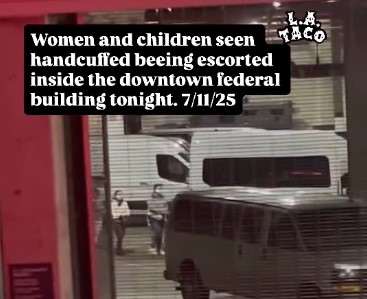At yesterday morning's Metro Operations Committee, a staff presentation gives a peek into a multiple new bus-only lanes planned for downtown L.A. streets. Metro is working with the L.A. City Transportation Department (LADOT) to implement bus-only lanes on 5th Street, 6th Street, Grand Avenue, Olive Street, and Aliso Street.
Metro has seen average bus speeds decline for more than a decade.
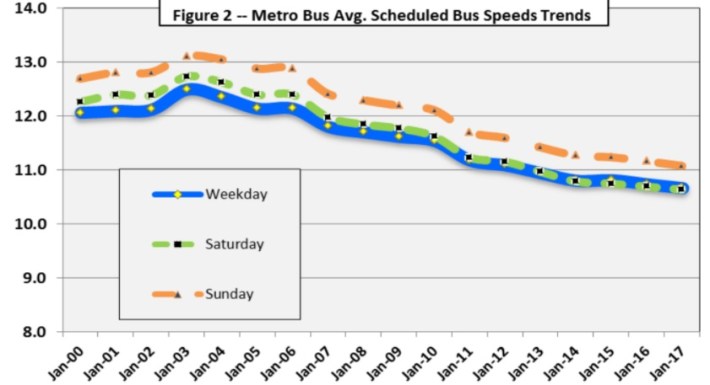
In July 2019, as the NextGen Bus Study appeared to be approaching implementation, the Metro board approved a bus speed improvements motion by boardmember Mike Bonin. That motion directed the agency to:
- incorporate priority bus speed infrastructure projects in NextGen
- convene a bus speed work group with LADOT, reporting back to the Metro board operations committee quarterly
- coordinate with local jurisdictions and municipal operators to improve bus speeds where bus delays exist
Bonin followed that up with a city motion directing LADOT to work with Metro on these improvements.
Yesterday's committee meeting was the first report back (staff report, presentation) from Metro 's NextGen Bus Speed Engineering Working Group, which has been meeting since December 2019.
Metro's Director of Service Planning Stephen Tu reported on the "runaway success" of the Flower Street bus-only lane. That peak-hour bus lane facility opened June 1, 2019, as part of Metro's New Blue temporary closure of the Blue (now A) Line. Metro extended the Flower bus lane pilot through June 2020, and now the working group is recommending it be made permanent.
Tu reported several Metro findings for Flower. The Flower bus lane has served 86 percent of total people on Flower Street, compared with only 14 percent in private vehicles in the two other general lanes - a third of the street carries 5/6ths of the street's capacity. Flower bus travel speeds improved by up to 30 percent. Bus ridership increased 32 percent during bus lane hours, even after trains resumed operations. The Flower bus lane's impact to car traffic was relatively minor, with speeds slowing by 2 mph on a 35 mph street.
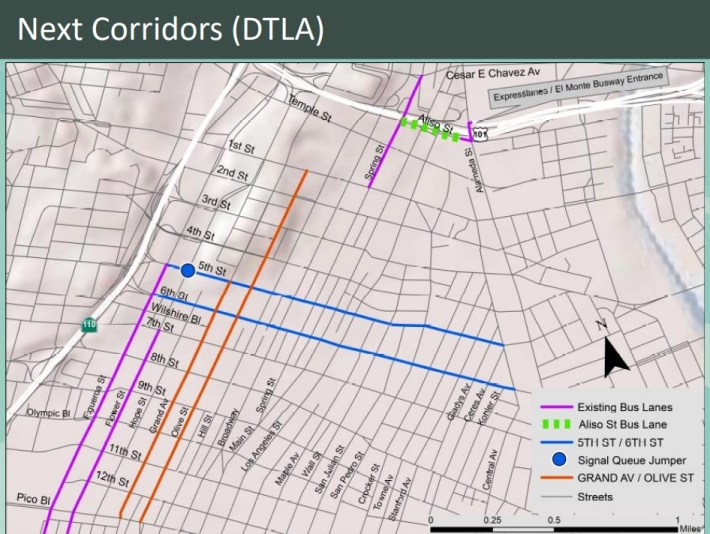
The following new bus-only lanes are planned for downtown Los Angeles:
5th and 6th Streets
Metro and LADOT are planning a bus lanes couplet on 1.2 miles of 5th Street one-way westbound from Central Avenue to Figueroa Street, and 1.3 miles of 6th Street one-way eastbound from from Figueroa Street to Central Avenue.
The project includes a "signal queue jumper" - a sort of bus headstart signal phase - at 5th and Flower. In this location, buses pick up riders on the right side of the street (across from the downtown library) then need to merge all the way to left to continue on surface streets into Westlake. This merge conflicts with cars merging to the right to get onto the 110 Freeway. The queue jumper would give buses their own dedicated signal phase, allowing buses to merge left early before cars enter the intersection.
The bus lanes will operate weekdays between 7 a.m. and 7 p.m., when, according to the staff report, more than 80 buses per hour currently use either 5th or 6th. These include several of Metro's heaviest ridership lines: the 20/720 (Wilshire Boulevard/Whittier Boulevard), the 16/17/316 (Third Street) and 18 (Sixth Street/Whittier Boulevard.)
The Metro staff report notes that preliminary traffic estimates show that "both 5th and 6th Street have sufficient capacity along the entire corridor to install a bus only lane without significant impacts to general traffic." Metro reports that community outreach for the new bus lanes began in March 2020, and were shortly put on hold due to the COVID-19 pandemic. The agency nonetheless "expects to complete public outreach, engineering design and installation of this project by December 2020."
The full bus lane extents of 5th and 6th are slated to be repaved very soon under the Bureau of Street Services ADAPT program. Failing to install the bus lanes at that time would increase the city's striping costs.
One aspect of the 5th and 6th Street bus lanes project that didn't quite make the Metro staff report is planned bike lanes on these streets.
Since 2017, L.A. Community Action Network (LA CAN) has been campaigning to add bike lanes on 5th and 6th Streets through Skid Row. Those two streets are heavily used by unhoused cyclists, who are often injured by fast-moving drivers. Both are on the city's High Injury Network. In 2018, LA CAN, working with the L.A. County Bicycle Coalition and others, succeeded in getting a city council motion passed to add these lanes to the city's Mobility Plan's bikeway network.
Outside of Figueroa Street (the MyFigueroa project), pretty much all L.A. City bus-only lanes are shared by buses and bicycles. Though transit buses and bikes share these (and right lanes all over) fairly well, it can be somewhat problematic. Slower cyclists sometimes slow down buses. Many cyclists feel uncomfortable and unsafe maneuvering around large buses. Sometimes bus lane enforcement wrongly targets cyclists.
One solution that has worked to minimize bus-bike conflict on some downtown L.A. one-way streets - Spring Street and Main Street - to move bicyclists to the left side of the street.
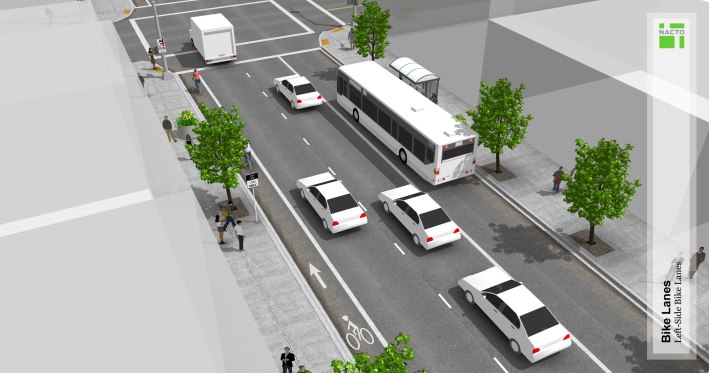
One-way street left-side bike lanes is a national best practice, used in many cities including throughout New York City. In addition to avoiding bike-bus conflict, it minimizes dooring and improves cyclist visibility. Where space permits, left-side bike lanes can be protected, as seen in San Francisco, Denver, and Manhattan.
Space tends not to be a constraint in adding one-way bike lanes to one-way streets. It only takes five feet to add one-way bike lanes - only four feet where there is no parking.
Aliso Street
Metro and LADOT are planning about a quarter mile of new eastbound bus lane on Aliso Street from Spring Street to Alameda Street - essentially extending the existing Aliso/Alameda bus-only left turn pocket for three blocks.
According to the staff report, this short stretch currently serves 60 buses per hour, primarily Metro J (Silver) Line and Foothill Transit Silver Streak as they access the El Monte Busway at Alameda Street. During NextGen outreach, Metro heard from numerous riders and bus operators that buses were encountering significant traffic congestion there. Per Metro's preliminary traffic study "a bus only lane can be installed without significant impacts to general traffic, above and beyond the usual traffic conditions along the 101 Freeway."
Metro and LADOT are in the community outreach process for this facility, also made difficult under COVID-19. Nonetheless, Metro anticipates opening these new lanes in June 2020.
Olive Street and Grand Avenue
Metro and LADOT are planning a bus lanes couplet on one mile of Grand Avenue one-way southbound bus lane from 5th Street to Pico Boulevard, and 1.5 miles of Olive Street one-way northbound from from Pico Boulevard to First Street.
Tu mentioned that this couplet is needed, as running too many buses is straining the capacity of the adjacent Flower/Figueroa couplet. This project appears on Metro's presentation map (above) but not in the staff report. One thing that might help speed up this project is that much of both of the new bus lanes are on stretches to be repaved soon under ADAPT.
As outlined above, moving Olive and Grand's existing bike lanes to the left (and adding left-side bike lanes north of where they currently end ) could help minimize bike-bus conflict. The current mostly-buffered bike lanes could be upgraded to protected where space permits.
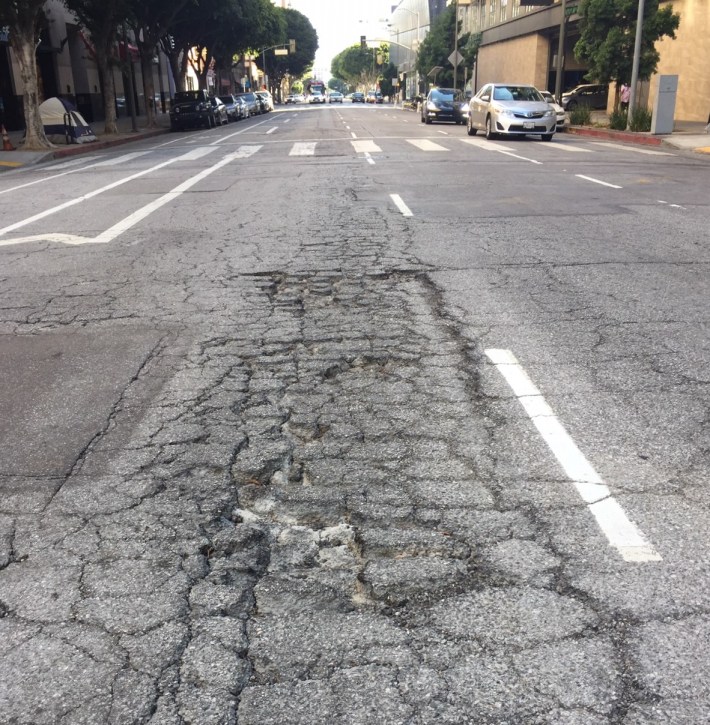
Additional Improvements
Tu mentioned three more ways Metro is working on improving bus speeds:
- Metro's working group is discussing future bus-only lanes outside of Downtown Los Angeles. No locations were named, though Metro has several past bus lane studies to draw from.
- Metro is expanding Transit Priority Signaling (TPS) to the entire Metro bus fleet. Currently only Metro Rapid buses have TPS technology which can extend green lights.
- Expanding all-door boarding. County Supervisor Janice Hahn's July 2019 motion directed Metro to expand all-door boarding, though Metro appears to have delayed the motion's report back requested in December 2019.
Prioritizing Bus Lanes Under COVID-19 Recovery
Separate from the bus speed working group, Metro's COVID-19 Recovery Task Force is also making the case for quickly implementing bus-only lanes. That task force is recommending that Metro: (see staff report)
Partner with local jurisdictions to accelerate implementation of bus-only lanes in areas that Operations has identified as past congestion hot spots.
The current period of lighter than usual vehicle traffic is a chance to implement more bus lanes with fewer immediate conflicts with traffic and parking. Bus-only lanes will allow greater speed and reliability, helping keep buses competitive with single occupancy vehicles. Faster travel can also contribute to more frequency and less crowding.
There is an equity opportunity to prioritize bus-only lanes on routes used by essential workers and those that connect equity-focused communities.
